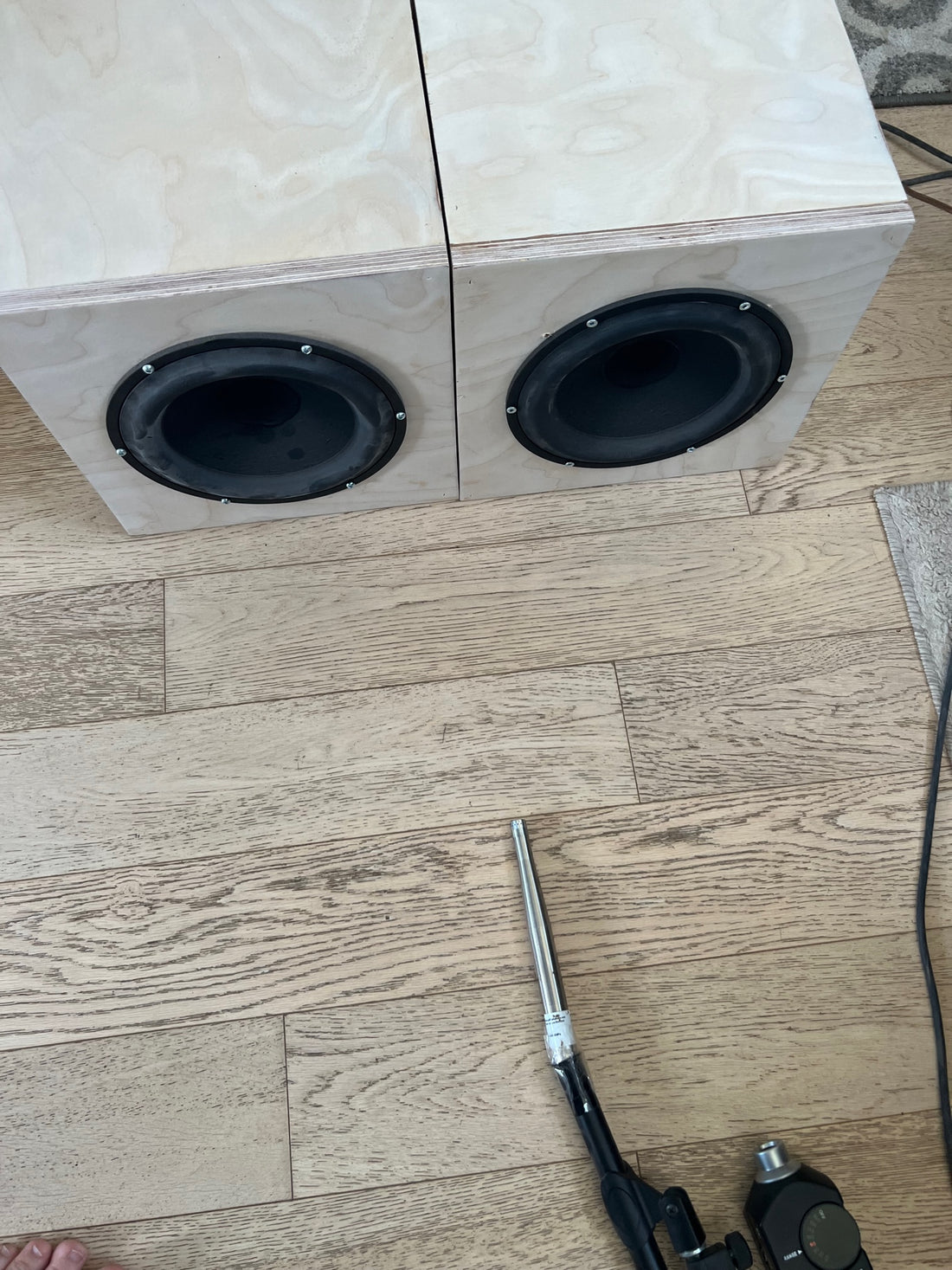Can two woofers more than double the distortion performance of just one woofer? Is there a mutual coupling benefit where the the two woofers are greater than the sum of both?
To determine this I configured a test where I evaluated the distortion performance of a single 8" woofer at a fixed SPL of 95dB. I then added a second woofer and adjusted the level to the exact same 95dB test signal. I then compared the distortion performance between the single and dual woofer setup.
Mathematically there should only be a -3dB distortion improvement with the addition of the second woofer.
Measurements
I began by measuring the harmonic distortion of the Scan-Speak 21W/8555-10 8" woofer at 95dB 1m. The woofer is mounted in a 11L sealed cube. I used the ground plane method for my mic position.

With the SPL carefully set to 95.00dB SPL@1m, I was able to get the following harmonic distortion sweep. With the cursor positioned at 100Hz we get the following results:
H2: -42.02dB
H3: -57.37dB
H4: -69.20dB

I then configured the dual woofers flanked horizontally and calibrated the SPL to the same 95.00dB as previous.

The distortion sweep for the dual woofer setup produced the following harmonic distortion result.
H2: -54.74dB
H3: -63.27dB
H4: -68.20dB

Tallying the result shows the following distortion reduction:
H2: -12.72dB delta
H3: -5.9dB delta
H4: +1dB Delta
We see that H2 and H3 are significantly more reduced than mathematically expected. H4 is likely into the noise floor of the setup and so it produced very little difference.
I then decided to measure the distortion for a vertically stacked arrangement. Ideally my mic should be positioned equal distance to each woofer however my mic stand could not reach that low, and so I left it in the same position on the floor as the other tests.

The vertical stack produced the following result.
H2: -43.02dB
H3: -60.01dB
H4: -69.59dB

H2: -1.00dB delta
H3: -2.64dB delta
H4: -0.39dB Delta
Initial Conclusion
The vertical stack roughly approaches a more mathematical result (-3dB) which is what one would expect. However the dual woofer flanked horizontally belies intuition providing a full -12.72dB and -5.9dB distortion reduction for H2 and H3 respectively.
Possible Explanation
The air cavity formed by the floor and baffle is physically larger with the dual woofer setup. This is possibly why we see an efficiency increase and thus lower distortion. Each woofer operates more efficiently with the aid of the adjacent woofer baffle. The vertical stack evidently does not provide the complimentary boundary reinforcement of the horizontally flanked setup.
Context and Comparison
I went back in my records and pulled up an earlier test on a JBL 15" (2226J) pro sound woofer.
As you can see the JBL achieves world class performance for low harmonic distortion using the same 95dB test signal.
H2: -61.60dB
H3: -58.73dB

It's interesting that the horizontal dual 8" woofer configuration offered similar distortion performance as the single 15" JBL. This is food for thought for my future designs. The dual woofer concept presents a number of advantages:
- There are many more woofer models to choose from in the 8" or 10" category for home audio applications.
- This opens up the possiblity of using more consumer orientated brands such as SEAS or Scanspeak.
- Currently SEAS and Scanspeak do not offer very many 15" model woofers
- Dual woofers can be configured for series wiring allowing for 16ohm loads.
- This presents a distinct advantage for low power tube amplifiers
- The high frequency compression driver can be specified as 16ohm as well.
- Efficiency is increased by using multiple woofers
- Sensitivity stays the same when wired in series, but efficiency goes up by +3dB which is what really matters when using tube amps
- The mutual coupling of the horizonal arrangement would provide even more than +3dB gain
- Dual 10" SEAS W26FX for example would be 93dB at 1w (3.52V) which is around 100dB sensitivity (in-room).
- Can be configured with a larger biradial high frequency horn. Dual 10" woofers could be used with a 400Hz Fc horn arranged directly above the woofers.
- Superior pattern control lower down into the frequency range.
Final Conclusion
The smaller dual woofer arrangement (flanked horizontally) is an interesting alternative to the larger single woofer solution.
